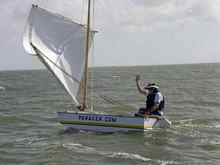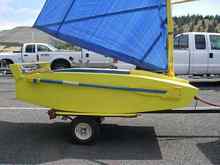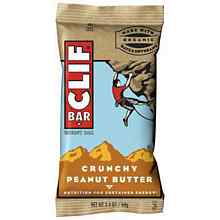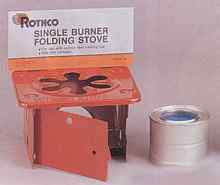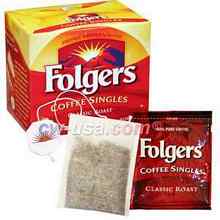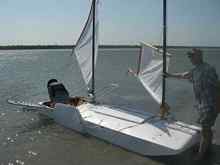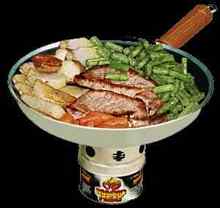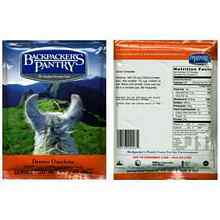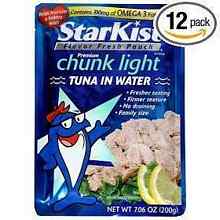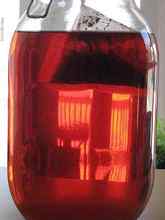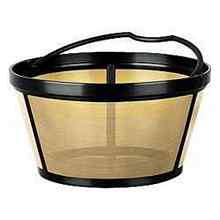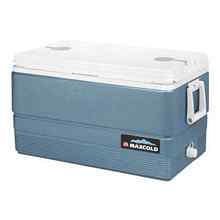
 Custom Search
|
|
| sails |
| plans |
| epoxy |
| rope/line |
| hardware |
| canoe/Kayak |
| sailmaking |
| materials |
| models |
| media |
| tools |
| gear |
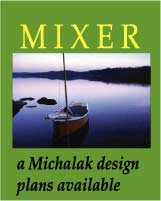 |
 |
| join |
| home |
| indexes |
| classifieds |
| calendar |
| archives |
| about |
| links |
| Join Duckworks Get free newsletter Comment on articles CLICK HERE |
|
|
| Simple Boat Food |
by Bill Nolen - Oklahoma City - USA |
I believe I'm on firm ground if I say that most of us like to eat. It's also true that many of us don't give a lot of thought to food until we are hungry! On land it's a simple matter to satisfy those hungry pains by swinging by a Wendy's, or Pizza Hut. However, when on a small sailboat it's a different matter. When sailing or anchored in some inlet, should we be luckily enough to have a spouse or other companion, we can look at them and ask what's for breakfast, lunch, or dinner? Much of the time the actually provisioning of our boats or the planning of the meals is not of much interest to us Skipper's. until mealtime! I thought it might be interesting to find out what the average sailboat skipper ate when he provisioned his boat without help or minimum help from a first mate. So I tracked down some noted sailors, and I asked for information on the subject of their boat food. Here are some of the replies I received, broken down somewhat by the size of the sailboat. Very Tiny Small Sailboats: Other than some freak size sailboat designed to set world records, the smallest sailboat that I know of that has been used for multi-day cruises, is the 8-foot home-built wooden Puddle Duck Racers (PDR). For the past few years several owners of these little boats have entered, and have completed the Texas 200, a five-day 200-mile voyage.
Here is how some of the PDR boats were provisioned for the five-day event. Simplest was the provisions that Andrew Linn, Salem, Oregon carried and ate for five-days, for two Texas 200's.
Andrew ate five Clif Energy Bars a day. One at 6 Am, 10 Am, Noon, 3 PM, and the last one just before reaching camp each evening. Andrew wrote me: "Clif Bars have a fair amount of nutritional content for the roughly 250 calories per bar. I also took a multivitamin, and drank two quarts of Tang per day, for about 160 calories per quart."
My idea is that sailing itself is not too stressful, so 1250 calories per day of Clif Bars and 320 calories per day of Tang would be more than sufficient to sustain me for five-days." Andrew went on to say: "I've done the Texas 200 twice on this diet, and if I do the Texas 200 again, I'll do this diet again". PDR Skipper John Wright of Bastrop, Texas took a more conventional approach in his provisioning. Here is what John carried in the boat's small storage compartments during one Texas 200:
John wrote: "I bought some little juice cartons with the straw attached, but this turned out to be a bad idea because the cartons create a lot of garage. On a boat garbage is bad!" John also wrote: " The only really important thing was coffee, several times a day made in the style of tea bags. I have a large porcelain steel cup that I heated with Sterno that fits a little stand made for this purpose. It is light but slow heating, especially in the wind. The dehydrated soup was heated the same way."
Kevin Allison of Houston, Texas provisioned his boat with backpacking Mountain House brand dehydrated meals sold by Academy. Kevin stated he liked the Beef Stroganoff, Chicken Teriyaki, and Spaghetti the best.
Kevin wrote: "I ate dehydrated backpacking meals, one in the morning and one in the evening. Each meal provided right around 500 calories. I had a small camp stove that used Magic Heat (a Sterno type jelled alcohol product). It took about 15 minutes to get the water hot enough to cook or make coffee with. That's 30 minutes of time that I had to take into account for before daybreak! Next time I'll have a true backpackers stove that can boil water in one to three minutes."
"For coffee in the mornings I used Forger singles (tea bag like packets). I started with five gallons of water and ended up using almost ten gallons from Sunday to Friday. I had small packets of energy drink type flavorings that I would add to the water jug towards the end of the day for electrolytes and a change of taste!" "As I heated and prepared my morning meal, I would work on my days snack bag. In the bag went trail mix with dried fruits, beef jerky, cheese n crackers, a few chewy fruit candies and a couple of hard candies, all thrown together for easy access throughout the day." "I would do it the same next year. I over packed this year (2009) planning for three meals a day for seven days. Next year I would plan on two meals a day for seven days. I will use a better quality camp stove that will boil water quickly so that I don't have to get up quite so early!" Jason Nabors, of Somerset, Texas, wrote "I started dieting in February before the Texas 200, so basically I had to watch how many calories I was eating. Some people think you want to pack on the calories while camping, and I guess if you are hiking, canoeing/kayaking, or mountain climbing this would be the case. But sitting in a boat for a week, moving a rudder and adjusting a main sheet does not requite many calories. According to my diet and weight I need a lot less than 2000 calories daily to function for a week, so this is what I did: I searched a favorite web site of mine that gives a calorie count of pretty much any food item that is carried by any supermarket anywhere. I found that the lowest calorie, most portable food, was the Backpackers Pantry Meals. They are like the Mountain Home dehydrated meals. As a mater of fact, they are sold next to them in most of the Academy stores.
I thought these meals would be great, until I got them home and tried one! They were bad! They are a salty mass produced mess, as bad, if not worse than a military M. R. E. I scrapped the ideal of eating these meals because the last thing I wanted was to be sick on the Texas 200. One day I was at my favorite camping store (AKA Dollar General) and as I was browsing their grocery isle to see if I could supplement a meal or two with some of their high calorie meals. That is when I saw ZATARAINS Rice Meals.
The ZATARAINS meals were 300 calories or less and they were not gourmet but leaps and bounds better than the dehydrated camping meals they had at Academy. Not to mention they were only two-dollars each compared to the six-dollars that was being charged for those crappy camping meals! I bought nine of them. I also bought nine Tuna Pouches (70 calories each), and nine Special K Cereal pouches (100 calories each), as well as bananas and grapefruit (about 80 calories each) To add favor to the Tuna my wife went to gas stations that sold hot dogs and loaded up on free prepackaged condiments like relish, onions and prepackaged mayo. These worked great for lunches.
I brought eight-gallons of water with me and I could have use another gallon. I also brought tea bags with me and would open a gallon of water and add four tea bags to the water; I would place the cap back on the container and let it sit in the cabin for about 30-minutes and VIOLA! Fresh sun tea!
Now, for the people who don't know that STERNO stoves won't really peculate a coffee pot. So here is what I did to make coffee. Instead of taking a coffee pot, I would take a small pot and placed a permanent coffee filter in it. I would then place three-tablespoons of ground coffee into the filter, and added water into the pot until it was about ¼-inch below the top of the coffee filter. I would then bring the water to a rolling boil, or at least close, and then remove the filter (with coffee grounds) and set the filter on top of my coffee cup and pour the water/coffee through the filter which filtered out all stray coffee grounds. Hurray! Coffee!
If you have room for a propane store and coffee pot on your boat, by all means take one. But, if you are in an eight-foot box sailboat with limited space, Multi Tasker's are important. I hope this information helps." Jason Nabors Micro and Compact Cruisers: Many owners of Micro and Compact sailboats have made multi-day voyages in their sailboats. Here is a sample of the type of food they carry and eat. Here are comments offered by John Stevens, Precision 23 Sailboat. "I precook all meals and freeze them. I put the meals in zip lock freezer bags. I boil water and put the freezer bag in the water to heat the food, the hot water is later used for coffee or tea. For ice, I freeze water bottles. As they thaw, they become my drinking water. I do the same with lunch meats. I leave the bread out in the cabin. I per-measure the roast beef and cheese, put it in a zip lock and freeze it. I take out the freezer bag in the morning and it's usually thawed by noon. I also use two coolers. A large cooler and a small cooler used for the first day and night. That way, I don't have to open the main cooler until the second day. I keep the main cooler organized, grab the food for that day and close it! I have also used extra foam inside the main cooler to make it even more effective. The only meal I cook from scratch is breakfast. Eggs, pancakes (buy the just add water kind),- breakfast meats are precooked and heated " John Madill, owner of P-15 Mackinac Dreamer, had this comment about eggs for breakfast: "Use Egg Beaters. They come in a milk carton container, pint or quart size. Freeze a pint size and you will get about 3 breakfasts from it. I find they taste good, and they're better for you." Westcoaster, owner of a O'Day 19, wrote: "Most of my cooking is one pot. I often cook instant white or brown rice, then before it's finished I add like a can of salmon or tuna (which I buy on the Coast that is locally canned). Some veggies thrown in, I like cooked pineapple, small cans of tomato sauce, etc. The rice makes a good base for most anything and nowadays there's pouches of cooked meat of several varieties. I have food allergies so always try to find foods 'not on my list'. I have never used freeze dried anything so can't report on that. Once in mid Pacific, on a bigger boat, I baked a two layer cake for a friend's birthday. I cooked it in one of those flip over with a hinge in the middle omelet pans." Chuck Pierce, P-19, "Aldebaran", Beaumont, Texas does most of the cooking on his P-19, and he wrote: "I normally cook twice a day when we are on the boat, breakfast and dinner. For breakfast it is usually eggs and sausage, for dinner any number of things, but EVERYTHING has to be fixable in one pot or pan. We normally keep a day cooler and a separate one that has the food in it that gets opened only once a day. In the heat we have down here, we have to buy ice every 3 days, a small price to pay for such luxury. Here is one of Chuck's recipes: Sausage and Egg Wraps Takes one Teflon coated pan and a spatula. Spray the frying pan with Pam. Cut up 2 Jimmy Dean precooked sausage links (their maple flavor is good) per person into 6-7 pieces each. Brown over medium-high heat, then turn off burner and let stand for a minute or so. Break 2 eggs per person into pan containing browned sausage and scramble thoroughly. Turn burner back on and cook eggs to taste. Remove pan from heat, warm 8" flour tortilla directly on burner (on our stove you can do this, depends upon the stove). Spoon eggs and sausage onto a tortilla and wrap! No plates, no forks. If you used enough Pam you can wipe the pan clean with a paper towel." On the subject of Ice Ray Frechnette wrote: Block ice lasts considerably longer than cubes. Draining melt water adds considerably to number of days the ice will last as well. I use an Igloo Maxcool cooler rated to keep food cold 5 days in 90 degree heat. Basically it has more insulation that other lesser coolers. So much determines how long a cooler keeps ice. How full the cooler is, what temps foods were at when placed in, ambient air temps, Solar gain or not, and how often you enter the cooler. With our Maxcool cooler we can last 5 days without any bought ice.
We typically cook foods we will eat at home and freeze it in day portions. We also freeze drinks in qt containers to include water and Gatorade. Our Maxcool Cooler is generally packed full of frozen food. Each night before bed, we pull out rations for the next day and place it in our daily duty cooler. This cooler that has stuff we want to keep cool but is not frozen. By lunch the foods are generally sort of thawed out and the water and drinks are starting to thaw. Sometimes we have the prior days drinks ready to go while the new days are still providing cool. All in all it works well for us, and the frozen cooler still has frozen stuff in it 4-5 days later when we do home. No Ice? Many noted sailors do quite well without ice, and pack food that needs no refrigeration such as small packages of Velveeta cheese, small cans of spaghetti sauce, pasta, canned vegetables, Spam, onions, garlic, evaporated milk, flour, rice, sugar, oil, Oatmeal packets, canned fish, salmon and mackerel. Here is what Anne Westlund wrote about provisioning her West Wight Potter 15 on the week long voyages she makes on Lake Huron. "On my P-15 "Peapod" I kept foods cold by using the time-tested method of wet towels. I wrapped eggs, cheeses, hard fruits, vegetables, bacon and lunchmeats in wet towels that I faithfully kept wet. That package rested in the cockpit in the shade as much as possible. I didn't try to carry more than a few days worth of lunchmeat. Cheese rarely goes moldy and if it looked like it might I wipe it with vinegar because wrapping it in cheesecloth soaked in vinegar keeps mold away. Usually I eat it too quickly for that to happen! All foods were in plastic bags with air squeezed out before wrapping in wet towels. I was able to buy smaller terry cloth towels at a Dollar Store and used those white towels - white to prevent heat gain. Even on the hottest days things stayed cool if not really cold." Bon Apite! https://www.wwpotterowners.com Here's a list of Bill's past articles: Harmonica - Part 1 - 2 - 3 - 4 - 5 - 6 - 7 A Simple Anchoring System (The Treasure Chest) Front Tiller (The Treasure Chest) |
 |
